

TEDxBrisbane 2011 - Paul Songhurst - One square metre at a time. GardenCity1. Garden City Model #1 | Garden City Model #2 Gudmundur Hannesson was a Professor of Medicine at the University of Iceland who developed the Icelandic interest in Garden City planning.
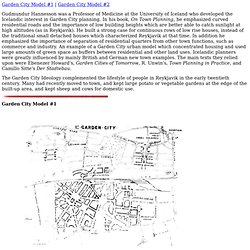
In his book, On Town Planning, he emphasized curved residential roads and the importance of low building heights which are better able to catch sunlight at high altitudes (as in Reykjavik). He built a strong case for continuous rows of low rise houses, instead of the traditional small detached houses which characterized Reykjavik at that time. E. HOWARD, GARDEN CITIES OF TO-MORROW. ICOS Citizenship - Team. DEMOGRAPHIA: Demographics Development Impacts Market Research & Urban Policy. World Population by continents and countries. More about population: Population by Countries List of population figures for all countries.
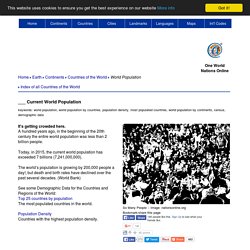
Countries by Area Global Village, Earth as a village of 100 people Have a look at the international community. World Urbanization Prospects, the 2011 Revision. World's fastest growing urban areas (1) The tables provide assumed annual growth rates for cities and urban areas between 2006 and 2020.

The assumptions are based on past growth/decline and forecasts by international and national statistics organisations. THE LARGEST CITIES IN THE WORLD AND THEIR MAYORS 2010 Introduction Cities by size: 1 to 150 | 151 to 300 | 301 to 450 | 451 to 550 | Cities in alphabetical order: A to D | E to L | M to R | S to Z | Cities by countries: A to D | E to L | M to R | S to Z | LARGEST URBAN AREAS: Introduction In 2006: Urban areas ranked 1 to 100 | Urban areas ranked 101 to 200 | Urban areas ranked 201 to 300 | Urban areas ranked 301 to 400 | In 2020: Urban areas ranked 1 to 100 | Urban areas ranked 101 to 200 | Urban areas ranked 201 to 300 | Urban areas ranked 301 to 400 | FASTEST GROWING URBAN AREAS: Urban areas ranked 1 to 100 | Urban areas ranked 101 to 200 | Urban areas ranked 201 to 300 |
The 10 Fastest-Growing (and Fastest-Declining) Cities in the World - Derek Thompson. A new survey from the Brookings Institution ranks the world's 200 largest metropolitan economies -- which account for half of global GDP -- from 1-200.

And the winners are ... Jordi AC/Flickr Shanghai is the fastest-growing city in the world, according to MetroMonitor, a quarterly analysis from the Brookings Institution that compares the 200 most prosperous metros by income and job growth. The victims of the euro zone crisis dominate the end of the list. Athens, Lisbon, and Dublin, the capitals of the three most endangered nations in Europe's sovereign debt crisis, made up the bottom three. Maps » Gridded Population of the World (GPW), v3. Planning and Development - Brisbane City Council.
Welcome to Brisbane City Council’s PD Online, an online Planning and Development System containing the following services PD Online may be subject to intermittent lapses of the availability of the service.

As a result, users seeking to view Development Applications may experience some delays during peak times. Should you experience any performance issues and you would like to make a submission (or feedback), please email your submission to Dalodgement@brisbane.qld.gov.au. Please ensure your email clearly identifies the development application to which the submission relates (with Council reference number and street address), and include the name and address of each person who is making the submission. Be sure to attach any supporting documentation. Domesday Book. Domesday Book (/ˈduːmzdeɪ/ or US /ˈdoʊmzdeɪ/; Latin: Liber de Wintonia)[1][2] is a manuscript record of the great survey, completed in 1086 on orders of William the Conqueror, of much of England and parts of Wales: "While spending the Christmas time of 1085 in Gloucester, William had deep speech with his counsellors and sent men all over England to each shire to find out what or how much each landholder had in land and livestock, and what it was worth" (Anglo-Saxon Chronicle).
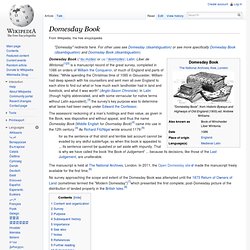
In Latin (though highly abbreviated, and with some vernacular for native terms without Latin equivalent),[3] the survey's key purpose was to determine what taxes had been owing under Edward the Confessor. The assessors' reckoning of a man's holdings and their value, as given in the Book, was dispositive and without appeal, and thus the name Domesday Book (Middle English for Doomsday Book)[4] came into use in the 12th century.[4] As Richard FitzNigel wrote around 1179:[5] Content and organization[edit] Survey[edit]
Featured Quote: Jennifer Robinson on Comparative Urban Studies. "The very fact that cities exist in a world of other cities means that any attempt at a general or theoretical statement about cities either depends upon or invites comparative reflection.
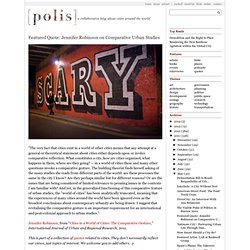
What constitutes a city, how are cities organized, what happens in them, where are they going? — in a world of cities these and many other questions invoke a comparative gesture. The budding theorist finds herself asking of the many studies she reads from different parts of the world: are these processes the same in the city I know? Are they perhaps similar but for different reasons? Or are the issues that are being considered of limited relevance to pressing issues in the contexts I am familiar with? European Institute for Comparative Urban Research. EURICUR (through Erasmus University) is the scientific partner of the European project CRII.

The aim of this project is through an integrated approach, to help increase the attractiveness of European Cities by promoting the restoration or further development of their identity, their image and variety. More information about this project can be obtained through the CRII website. European Institute for Comparative Urban Research. Projects » Projects overview Projects Empowering metropolitan regions through new forms of co-operation In the project 'Empowering Metropolitan Regions through New Forms of Cooperation' we analyse the development of cross-border and cross-sector partne.. read more...

Undue Subdivision of Land Prevention Act 1885. The Undue Subdivision of Land Prevention Act 1885 was a law passed by the Parliament of Queensland in that year to prevent overcrowding and urban degradation in cities and towns in Queensland, especially in Brisbane.
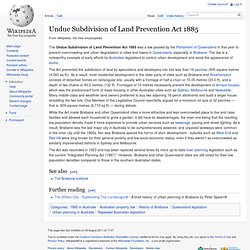
The law is a noteworthy example of early efforts by Australian legislators to control urban development and avoid the appearance of slums. While the Act made Brisbane and other Queensland cities a more attractive and less overcrowded place to live and raise families and allowed each household to grow a garden, it did have its disadvantages, the main one being that the resulting low population density made it more expensive to provide urban services such as sewerage, paving and street lighting. As a result, Brisbane was the last major city in Australia to be comprehensively sewered, and unpaved laneways were common in the inner city until the 1960s.
See also[edit] Design and Politics / Galleries / Design and Politics / 2011–2012 / Berlage Institute. Affordable rental housing. Affordable Rental Housing SEPP It covers housing types including villas, townhouses and apartments which contain an affordable rental housing component, along with secondary dwellings (also known as granny flats), new generation boarding houses, group homes, social housing and supportive accommodation.
New rules for complying development Changes to the State Environmental Planning Policy (Affordable Rental Housing) 2009 that effect complying development for secondary dwellings / granny flats and group homes will come into effect on 22 February. More information. Learn more about the changes to complying development. Previous amendments to the Affordable Rental Housing SEPP The NSW Government announced changes to the policy on 20 May 2011. Prof. Bill Hillier - Is London the Paradigm City or a one-off case? Rhythm. Compound triple drum pattern: divides three beats into three. Play Contains repetition on three levels. In the performance arts rhythm is the timing of events on a human scale; of musical sounds and silences, of the steps of a dance, or the meter of spoken language and poetry.
Rhythm may also refer to visual presentation, as "timed movement through space. "[3] and a common language of pattern unites rhythm with geometry. Anthropology[edit] Aitoa arkkitehtuuria. SOLUTIONS - Sustainability of Land Use and Transport in Outer Neighbourhoods. The 7 Fastest-Growing Cities in the World - An FP Photo Essay. Decision Theory for Planners #110 Why a City Scales like an Elephant « Decisions, Decisions, Decisions. Geoffrey West the noted English physicist has studied scale for many years, moving from looking at physics, to biology to now cities and firms. “I’ve always wanted to find the rules that govern everything,”“It’s amazing that such rules exist. It’s even more amazing that we can find them.” “We spend all this time thinking about cities in terms of their local details, their restaurants and museums and weather,”“I had this hunch that there was something more, that every city was also shaped by a set of hidden laws.”
West took an idea from biology, Kleiber’s scaling law, and tried to explain it. This looks at how the metabolism of a creature changes with size. This seemed to describe a certain increasing return to scale about physical phenomenon. West looked at whether this applied to cities, gathering massive amounts of information with his co-worker Luis Bettencourt. They found massive economies of scale in settlements, just as in big animals. Writings on Cities - Henri Lefebvre. High-Income World: Core Cities and Densification. Arquitextos 044.02: Projetos urbanos: operando nas bordas (1)
“Like a huge, dynamic mass of gridded patches and structureless emulsions of masonry, asphalt, cars and people, the colossus sprawls across the endless plateau and gobbles its way through the dark green forest, leaving little reddish spots behind. The new developments and the mutations follow the logic of land speculation and are driven by instantaneous impulses such as a randomly placed new factory or an equally randomly placed favela. Admittedly, the ring of motorways around and through the center, together with the railways and two rivers, form a bundle of infrastructure that allows us a distant panorama, and the built-up area occasionally follows an undulation of the landscape, but ultimately these nuances vanish amid the hugeness and chaos of the whole.
Thus Sao Paulo has the appearance of a vast, monotonous, dense uplift cut across by deep clefts…Every notion we may have about planning and architecture evaporates here. Fragments Sao Paulo Mutations Minimal 1. Wide Urban World: What is a city? Definitions of the urban. What is a city? How do we distinguish urban from non-urban settlements in ways that make sense?
Does it matter how we define cities, or is definition just a sterile typological exercise? Definition is crucial for comparison. If we are going to compare cities, or parts of cities, then it helps to have a clear and explicit notion of what we are talking about. Quality of life world map. The 7 Fastest-Growing Cities in the World - An FP Photo Essay. Growth spurt puts Brisbane on top of the world. Brisbane is growing faster than any comparable city in the world, according to a new report. Photo: Glenn Hunt Brisbane will grow faster than any other 'mature' world city over the next eight years, according to an international study compiled by market analysts Jones Lang LaSalle. The Centre for Subtropical Design - Events. World cities by population. A flexible city of strangers. Cities can be badly-run, crime-infested, dirty, decaying. Fractals. Sense of place.
Geographic place[edit] To understand sense of place, the geographic concept of space needs first to be defined. Geographic space is the space that encircle the planet or in orbit ones body, through which biological life moves. Homogeneity and heterogeneity. Homogeneity and heterogeneity are concepts relating to the uniformity in a substance. A material that is homogeneous is uniform in composition or character; one that is heterogeneous is distinctly nonuniform in one of these qualities.[1][2][3] The words homogeneous and heterogeneous come from Medieval Latin homogeneus and heterogeneus, from Ancient Greek ὁμογενής (homogenēs) and ἑτερογενής (heterogenēs), from ὁμός (homos, “same”) and ἕτερος (heteros, “other, another, different”) respectively, followed by γένος (genos, “kind”); -ous is an adjectival suffix.
Land Mosaics: The Ecology of Landscapes and Regions - Richard T. T. Forman. Invisible Cities. Invisible Cities (Italian: Le città invisibili) is a novel by Italian writer Italo Calvino. It was published in Italy in 1972 by Giulio Einaudi Editore. Description[edit] The city shaped: urban patterns and meanings through history - Spiro Kostof. Cities of refuge: the emergence of temporal urbanism. Human rights from the perspective of politics, art, philosophy (hence p.a.p.), law, economics, statistics, psychology etc. Why Monotonous Repetition is Unsatisfying, an article by Dr. Nikos Salingaros. "Public space is a physical expression of complexity" Self-organization and the city - Juval Portugali. Topophilia and the Quality of Life: Discussion. The City is like a large House « The Architecture of Analogy. And Study of Tenement Housing Type Perth [CAD plan section elevation]“] McEwan C (2011) Tenement Housing Type Perth [Photomontage Ordinary housing largely forms what we call the built environment, the city.
Italian architect Aldo Rossi said that the city is built around fixed points, “monuments.” 3D Map of London's Urban Complexity. In the Life of Cities...: Parallel Narratives of the Urban/LATIN AMERICA. Berlin: Symphony of a Great City [Act 2] Berlin: Symphony of a Great City [Act 1, Part 1] Casablanca. Mindrelic - Manhattan in motion. Brisbane. Porto Alegre. Porto Alegre (local Portuguese pronunciation: [ˈpoɾtʊ aˈlɛɡɾɪ] ( List of largest cities in Brazil. List of cities proper by population density. - Global Cities Research Institute. Emergent Urbanism, or ‘bottom-up planning’
An urban sustainability, green building, and alternative transportation community. Competitive Cities Conference » Housing . Urban Development . Communities » Brian Haratsis: Thinking big on population. Camillo Sitte.
Mumbai. Becoming Seven Billion - Environment - Browse - Big Ideas - ABC TV. Lagos. List of cities by latitude. Cities as Solutions.